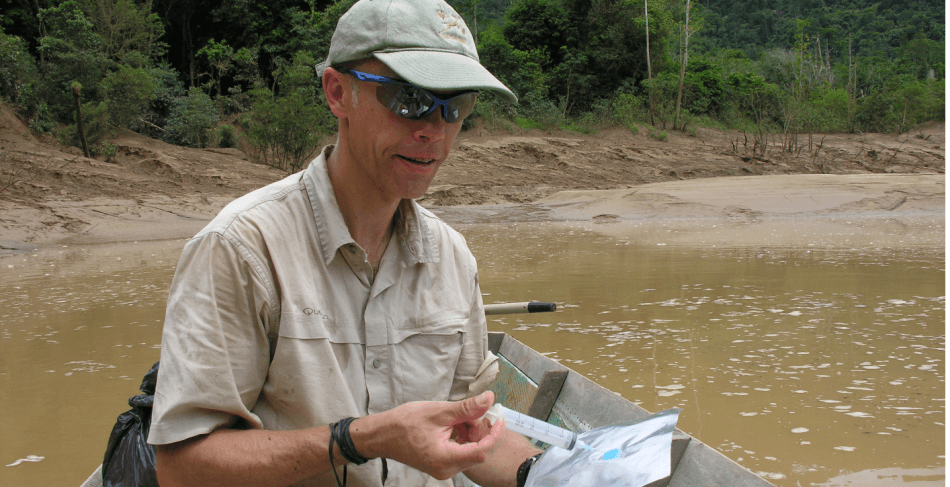Aug 7 2017
When hydropower reservoirs capture organic matter, it results in higher local greenhouse gas emissions. However, these emissions are not increased but displaced. A new instrument measures the real greenhouse gas footprints of reservoirs.
 Atle Harby is preserving a gas sample at Murum River in Malaysia. The gas sample are taken to the laboratory for analysis of methane and CO2 content to give information on natural greenhouse gas emissions before a new hydropower reservoir is created on the river. (Photo: Julie Bastien)
Atle Harby is preserving a gas sample at Murum River in Malaysia. The gas sample are taken to the laboratory for analysis of methane and CO2 content to give information on natural greenhouse gas emissions before a new hydropower reservoir is created on the river. (Photo: Julie Bastien)
Plants and trees capture CO2 from the atmosphere to grow. When organic matter such as fallen branches and leaves degrades, CO2 is emitted back into the atmosphere. Water carries the organic matter to the sea via rivers, and along the way it might discharge greenhouse gases such as methane and CO2. Construction of a reservoir stops the flow of water and traps a few organic matters.
“Greenhouse gases that are emitted in a reservoir may well have been emitted anyway. It is a displacement, not an increase, and this was not accounted for in earlier calculations. You must also consider the prior land use and the processes in the whole river basin,” says Atle Harby, an Energy Research Scientist at SINTEF, who has been involved in developing a tool, called G-res tool.
Reservoir emissions – a hot topic
The greenhouse gas status of freshwater reservoirs has been a trending topic over the last ten years. Impacts are frequently linked to hydropower projects, while a new framework and instrument from the International Hydropower Association (IHA) reveals that the truth is far more multifaceted.
The net emissions method takes into consideration naturally occurring emissions and emissions linked to other human activities. The G-res tool enables users to predict the real GHG footprint of reservoirs.
Hydropower adds no new carbon dioxide to the atmosphere
Nearly 20 years ago, stories started to emerge in the media that reservoirs built for hydropower projects were a chief emitter of greenhouse gases. Yet there were no real measurements to support the theories.
In 2006, the IPCC published their greenhouse gas guidelines that included three methods with formulas to measure emissions from reservoirs. Statkraft, Europe’s largest generator of renewable energy, used all three methods to assess their measurements taken at the Trollheim reservoir and hydropower plant in central Norway.
The first method using IPCC default values linked the emissions from Trollheim to those of a gas power plant. The second method used some of their own data and halved the projected emissions. Statkraft then got SINTEF involved to develop methodology and conduct measurements of emissions. The third method using this data revealed emissions from Trollheim would be about 2 g CO2eq/kWh, compared to 300 g CO2eq/kWh from a gas power plant.
A hydropower reservoir does not add any new carbon dioxide to the atmosphere, unlike fossil-fuel power plants.
Tormod Schei, who at the time worked as a Senior Environmental Advisor at Statkraft
A surprising find in Laos
The Nam Ngum reservoir in Laos is characterized by a warm and humid climate with thick forest in the upstream catchment region. If the initial claims were to be assumed, the tropical conditions should have been ideal for high greenhouse gas emissions.
However, a study from EDF and SINTEF published in the journal Science of the Total Environment in 2011 discovered that the 40-year-old Nam Ngum reservoir acts as a carbon sink, with negative net greenhouse gas emissions because of a high CO2 uptake by phytoplankton and low methane production.
Schei calls the launch of the tool a huge milestone in helping to evaluate the true value of hydropower.
In Turkey, the Ataturk dam and reservoir is delivering on irrigation, while in China, flood control and transportation are more important than the energy produced. Understanding the likely greenhouse gas emissions of a new reservoir is a vital step in proper management of energy production and the river system.
Tormod Schei, who at the time worked as a Senior Environmental Advisor at Statkraft
The IPCC are currently planning to revise their guidelines for national greenhouse gas inventories with the assistance of Atle Harby and 15 other Lead Authors. The chapter on how to handle freshwater reservoirs (flooded land) will be reviewed based on the new findings.